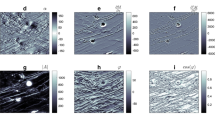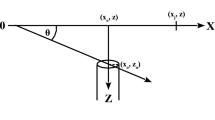Abstract
There are many semiautomatic interpretation methods for potential field data. Some only work for a specific model, such as a contact or dyke, while others can be applied to any structure which has a known structural index (S.I.) (which gives the rate of decrease with distance of the amplitude of the anomaly). Various strategies exist for the automatic determination of the S.I., some of which involve inversion, or the use of data from different altitudes. A simple new method of determining the depth, location, and S.I. of potential field sources is introduced here and demonstrated on potential field data from South Africa.





Similar content being viewed by others
References
Abo-Ezz ER, Essa KS (2016) A least-squares minimization approach for model parameters estimate by using a new magnetic anomaly formula. Pure Appl Geophys 173:1265–1278
Blakely RJ (1995) Potential theory in gravity and magnetic applications. Cambridge University Press, Cambridge 441pp
Cooper GRJ (2014) The automatic determination of the location and depth of contacts and dykes from aeromagnetic data. Pure Appl Geophys 171:2417–2423
Cooper GRJ, Whitehead RC (2016) Determining the distance to magnetic sources. Geophysics 81(2):J39–J48
Keating P (2009) Improved use of the local wavenumber in potential-field interpretation. Geophysics 74:L75–L85
Ma G (2013) Improved local wavenumber methods in the interpretation of potential field data. Pure Appl Geophys 170:633–643
MacLeod I, Jones NK, Dai TF (1993) 3D analytic signal in the interpretation of total magnetic field data at low magnetic latitudes. Explor Geophys 24:679–688
Reid AB, Allsop JM, Granser H, Millet AJ, Somerton IW (1990) Magnetic interpretation in three dimensions using Euler deconvolution. Geophysics 55:80–91
Smith R.S., Salem A. (2005) Imaging depth, structure, and susceptibility from magnetic data: the advanced source-parameter imaging method. Geophysics, 70 (4):L31–L38
Thompson DT (1982) Euldph: a new technique for making computer assisted depth estimates from magnetic data. Geophysics 47(1):31–37
Author information
Authors and Affiliations
Corresponding author
Rights and permissions
About this article
Cite this article
Cooper, G.R.J. Determining the depth and location of potential field sources without specifying the structural index. Arab J Geosci 10, 438 (2017). https://doi.org/10.1007/s12517-017-3229-0
Received:
Accepted:
Published:
DOI: https://doi.org/10.1007/s12517-017-3229-0




